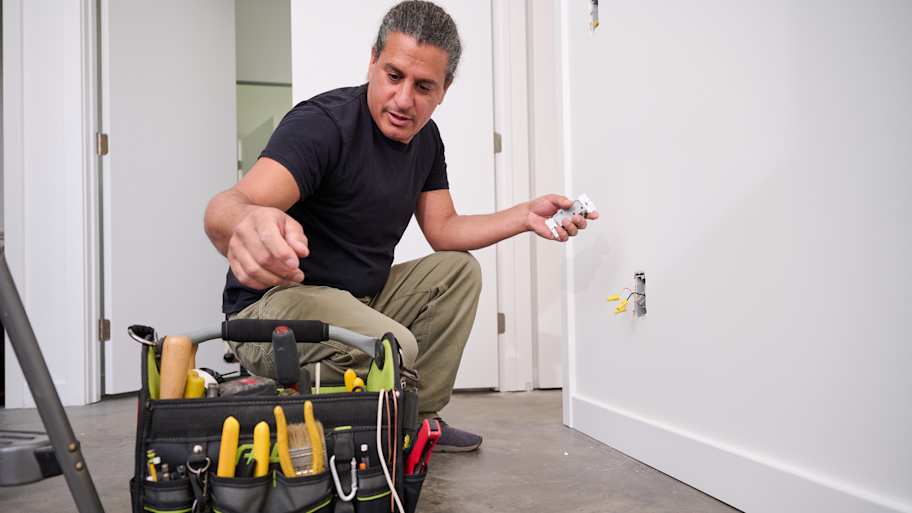Why Are My Lights Out But the Breaker Is Not Tripped?
Get to the source of the problem in no time


Lack of power could be the result of a loose connection, faulty wiring, tripped GFCI outlet, or blown fuse.
These issues are more likely if you have an older electrical system with a fuse box instead of an updated circuit breaker box.
The problem may be due to frayed wires or an old outlet that needs replacing.
Always ensure the power is off before you troubleshoot electrical problems.
Wondering why your power isn’t working but your switch breaker isn’t tripped? When turning on the light switch doesn’t illuminate your room, it can be a minor nuisance that adds just a little frustration to your day or night. And if you find your switch breaker isn’t tripped, this minor nuisance can quickly become a confusing one. Get to the bottom of your powerless light switch by looking at these common problems and solutions.
How to Find the Problem
Not being able to turn on your lights when you need to can be a big pain. Fortunately, there are several steps you can take to get to the bottom of the problem.
Keep It Simple
If there’s no power to your light switch, but the breaker has not tripped, checking the easy things first can help determine if a bigger problem is at play.
A burned-out light bulb could mimic a power outage to your light switch. Try replacing the bulb in the light fixture to see if this resolves the problem. Also, check to make sure that the lamp or appliance that you are trying to operate is fully plugged into the outlet before flipping the switch. With a busy household, things can easily become unplugged or forgotten about until you need to use them.
Inspect Your Light Switch

Take a good look at your light switch, especially if it’s old or frequently used. A damaged light switch could look melted, burned, or have scorch marks. These signs often mean there’s extra heat causing your light switch to not work, even though the circuit breaker hasn’t tripped.
Inspect the slide mechanism (or dimmer switch) if the light switch looks undamaged—it might be loose due to excessive wear and tear. If it is loose or is otherwise not working correctly, the mechanical parts in the switch may be worn out.
Other signs of a damaged light switch causing a lack of power are hearing a buzzing sound and feeling hot to the touch. These indicate that the current running through the wires is not flowing the way it should be—it’s instead jumping the gap between the metal parts (otherwise known as “arching”).
Most of these problems could potentially lead to a fire, so it’s important to take action quickly if you notice these signs. You’ll want to switch off the circuit breaker and replace the light switch yourself, or if you feel there’s a larger problem at hand, consult a local electrician to diagnose any problems.
Check for a Tripped GFCI

Ground-fault circuit interrupters (GFCIs) are circuit breakers that protect you from electrocution in the case of a ground fault. These receptacles contain mechanisms to quickly shut off the electricity to your outlets during a power surge. This same mechanism, however, can be the culprit behind a light switch that won’t work.
There are a few signs that your GFCI has tripped. While the lack of power to your lights is a major indicator of this, some other signs you should look at for include:
A popped reset button: Most GFCIs have reset and test buttons. If the GFCI has tripped, the reset button will pop out or move positions to indicate that it’s been triggered.
Indicator light off: Besides buttons, most GFCIs have an indicator light to show status. If the GFCI has tripped, the color will either turn off or change to a different color to show the status.
Other affected outlets: GFCIs are often connected in a series, meaning one can impact the others downstream. If one GFCI trips, it could also cause other light switches or outlets to lose power.
Check for Damaged or Loose Wires

Sometimes, the problem lies deeper than the surface of your outlet—inside the wall box. Wires can become loose, damaged, or frayed, putting your home at risk of fire or even leading to electrical shock. Having a wiring problem won’t trip your breaker, but it’ll certainly cause your light switch to work improperly.
To find out if you have a wiring issue, you can remove the light switch from the wall—but only after you’ve turned off the electricity to the switch. Inside the switch’s electrical box, you can check the quality of the wires to make sure they aren’t frayed or damaged.
How to Troubleshoot Your Light Switch Problems
You can resolve some of these issues by yourself, while others will require the help of a licensed electrician. Remember to always practice safety when doing electrical work and never take on a DIY you’re uncomfortable with.
Fixing Damaged Wires
If your wires have frayed ends, you can often fix this yourself without calling in the pros. You’ll want to first shut off the breaker box to do this. After removing the light switch cover, you’ll clip and strip the frayed wires. Then reconnect the wire, replace the light switch cover, and turn the breaker back on to test if it works.
Likewise, if you see wires poking out of the wire terminals, you may only need to resecure the wires to the terminals and then apply electrical tape to the outlet or switch to secure them away from the sides of the box.
For wires that are beyond repair, or if you don’t feel comfortable working with exposed wires, you’ll need a local electrician to replace them entirely.
Resetting A Tripped GFCI
To check for a tripped GFCI, visually inspect the receptacle. Depending on the type of GFCI outlet, you might see a red light. This indicates that either the receptacle tripped or it’s not working properly. Hit the ‘RESET’ button on the GFCI to reset the circuit breaker. If this doesn’t fix the issue, you can also try testing your GFCI to see if it needs replacing. GFCIs need annual testing to ensure they’re protecting your outlets.
Repairing an Electrical Outlet
How you repair an electrical outlet depends on the issue at hand. In some cases, your outlet is beyond repair and needs replacing. If your outlet shows any of the signs above, you’ll want to contact a licensed electrician to repair or replace the electrical outlet.
Follow Safety Measures When Working with Outlets
Just because your light switch isn’t working in a given room, it doesn’t mean that electricity isn’t running altogether. You should never attempt to tinker with the wires of an outlet without checking that it’s truly free of an electrical current. Knowing if there’s power in your outlet can tip you off to underlying problems. It can also help keep you safe.
To test an outlet for signs of voltage, use a multimeter. A multimeter device can detect low levels of electricity to help you figure out if the source of the problem stems from the light switch itself.
If you can’t detect power in any of the outlets in a given circuit, and the issue isn’t a faulty GFCI, then you know there might be a bigger problem on hand that warrants the help of a trained electrician.
When To Call in the Pros
When you’ve tried all of the simplest troubleshooting methods only for your lights to stubbornly remain off, it might be time to call in an electrical company. Your local electrician knows all the ins and outs of even the most sneaky causes of power outlets and light switches that won’t work and can have your power back up and running in no time.
Frequently Asked Questions
You can have power but no lights if the light switch is damaged. A damaged light switch is often caused by regular wear and tear or loose wires. In addition, simple problems such as a burnt-out light bulb or an unplugged lamp could be the cause of not having working lights.
A new circuit breaker costs anywhere between $10 and $100 on average, depending on the type of circuit breaker. A standard circuit breaker is the most affordable, while a GFCI or AFCI circuit breaker will cost the most. If you’re upgrading to a higher amperage, anticipate paying closer to $250 to $350 for a 200-amp circuit breaker.





- Home Generator Repair
- Lamp Repair
- Electric Repair
- Generator Installation
- TV Antenna Services
- Emergency Electricians
- Commercial Electricians
- Attic Fan Installation
- Attic Fan Repair
- Exhaust Fan Installation
- Electric Inspectors
- Subcontractors
- Electrical Construction
- EV Charger Installer
- Chandelier Installation
- Doorbell Installation
- Bathroom Fan Installation
- Ring Installers
- Electrical Panel Upgrade
- Can a Light Switch Go Bad?
- 3 Reasons Why Your Light Switch Won’t Turn Off
- How to Fix an Outlet That Stopped Working When the Breaker Has Not Tripped
- How to Install a Smart Light Switch
- Home Electrical Repairs: Basic Wiring and Electrical Repairs
- Outlets Not Working in One Room? Here’s How to Solve
- Why My Breaker Switch Won’t Stay On and How to Fix It
- What Is a Three-Way Switch and How Does It Work?
- 4 Ways to Fix Bathroom Outlets That Are Not Working
- Is a Dead Outlet Dangerous? What You Need to Know










